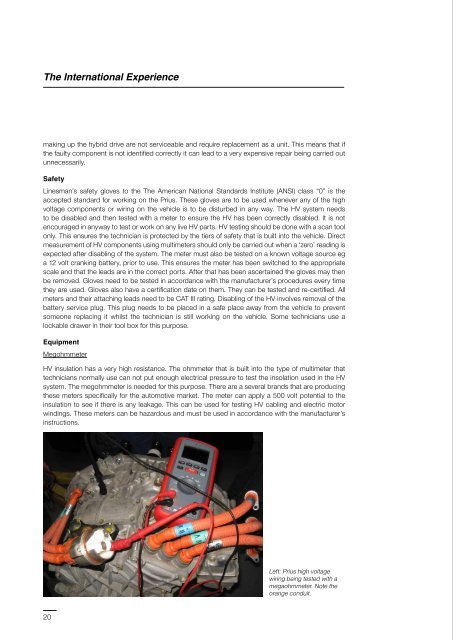Electric and Hybrid Vehicle Maintenance, Service and Repair.
Electric and Hybrid Vehicle Maintenance, Service and Repair.
Electric and Hybrid Vehicle Maintenance, Service and Repair.
Create successful ePaper yourself
Turn your PDF publications into a flip-book with our unique Google optimized e-Paper software.
The International ExperienceThe International Experiencemaking up the hybrid drive are not serviceable <strong>and</strong> require replacement as a unit. This means that ifthe faulty component is not identified correctly it can lead to a very expensive repair being carried outunnecessarily.SafetyLinesman’s safety gloves to the The American National St<strong>and</strong>ards Institute (ANSI) class “0” is theaccepted st<strong>and</strong>ard for working on the Prius. These gloves are to be used whenever any of the highvoltage components or wiring on the vehicle is to be disturbed in any way. The HV system needsto be disabled <strong>and</strong> then tested with a meter to ensure the HV has been correctly disabled. It is notencouraged in anyway to test or work on any live HV parts. HV testing should be done with a scan toolonly. This ensures the technician is protected by the tiers of safety that is built into the vehicle. Directmeasurement of HV components using multimeters should only be carried out when a ‘zero’ reading isexpected after disabling of the system. The meter must also be tested on a known voltage source ega 12 volt cranking battery, prior to use. This ensures the meter has been switched to the appropriatescale <strong>and</strong> that the leads are in the correct ports. After that has been ascertained the gloves may thenbe removed. Gloves need to be tested in accordance with the manufacturer’s procedures every timethey are used. Gloves also have a certification date on them. They can be tested <strong>and</strong> re-certified. Allmeters <strong>and</strong> their attaching leads need to be CAT III rating. Disabling of the HV involves removal of thebattery service plug. This plug needs to be placed in a safe place away from the vehicle to preventsomeone replacing it whilst the technician is still working on the vehicle. Some technicians use alockable drawer in their tool box for this purpose.EquipmentMegohmmeterHV insulation has a very high resistance. The ohmmeter that is built into the type of multimeter thattechnicians normally use can not put enough electrical pressure to test the insolation used in the HVsystem. The megohmmeter is needed for this purpose. There are a several br<strong>and</strong>s that are producingthese meters specifically for the automotive market. The meter can apply a 500 volt potential to theinsulation to see if there is any leakage. This can be used for testing HV cabling <strong>and</strong> electric motorwindings. These meters can be hazardous <strong>and</strong> must be used in accordance with the manufacturer’sinstructions.MilliohmeterThis meter is primarily used for looking for short circuits in the windings of electric motors. Once again,the conventional multi-meter technicians currently use is not accurate enough.Manufacturers depend on using the factory scan tool <strong>and</strong> access to the TIS or Technical informationserviceBattery packThe battery pack contains the nickel-metal hydride cells, system main relays, service plug connector,various sensors <strong>and</strong> the battery ECU. The battery pack is only serviced as a whole assembly fromthe manufacturer, but aftermarket repairers are now carrying out repairs on packs that are no longercovered by warranty. This is not being endorsed by the manufacturers.DiagnosisCritical to fault diagnosis is access to manufacturer’s technical information. In the US technicianscan subscribe to Toyotas ‘TIS’ (Technical Information system). This gives access to online workshopmanuals, wiring diagrams, technical service bulletins <strong>and</strong> other information to service <strong>and</strong> repair Toyotavehicles from 1990 on. There are different levels of subscription based on the repairer’s requirements.Scan tools which enable the technician to read the DTC (diagnostic trouble codes) <strong>and</strong> data in thevehicles ECU are essential to these vehicles. Some aftermarket scan tools do access the systems,but for a comprehensive view the manufacturers scan equipment is preferred. Toyota markets its‘Techstream’ <strong>and</strong> ‘Techstream Lite’ scan tools. They use wireless connection to the internet sotechnicians can sit in the driver’s seat <strong>and</strong> browse the TIS whilst reading vehicle data <strong>and</strong> DTCs. Bothof these systems require annual subscriptions to stay connected to the TIS. The Techstream is the fulltool whilst the ‘Techstream Lite’ is an interface for a laptop computer.Another more conventional diagnostic technique is using oscilloscopes. Although commonly used onconventional vehicles they will have new applications for HEV’s. One example is the electric coolantpumps for the inverter that do fail. The oscilloscope with an inductive low amps pickup can be usedto predict this. Oscilloscopes are also very useful instructional tools for practical demonstrations ofcurrent <strong>and</strong> voltage variations in circuits. These concepts can be difficult for students not yet familiarwith electrical theory. The oscilloscope provides an image for them to underst<strong>and</strong>. Often, techniciansare visual learners.Compression testing the ICE must be carried out using the scan tool. The ICE will be cranked by MG1at approximately 1000 rpm. Audibly the ICE will sound the same as if it is running, but in fact is beingdriven electrically. All service specifications Toyota gives are for these conditions.<strong>Hybrid</strong> Transmissions. Sinclair trainer: John Porter.<strong>Hybrid</strong> systems are often defined as series, parallel or series-parallel. These definitions are not clear assome vehicles can change modes under different operating conditions. Manufacturers also have theirown terminology that can cause some confusion.Series hybrids do not use ICE to propel the vehicle directly. The ICE is there to drive the generator toproduce electrical power. Generally the transmission in a series system does not provide torque <strong>and</strong>speed management as in a conventional transmission. This allows the Ice to be designed to give goodtorque over a small rpm range as its speed is independent of road speed.Left: Prius high voltagewiring being tested with amegaohmmeter. Note theorange conduit.Parallel <strong>Hybrid</strong>s provide propulsion through an electric motor or ICE. Because of the comparativelynarrow torque curve of the ICE, the parallel hybrid systems benefit from a multi-speed transmission.They can be CVT, manual or automatic.2021
















